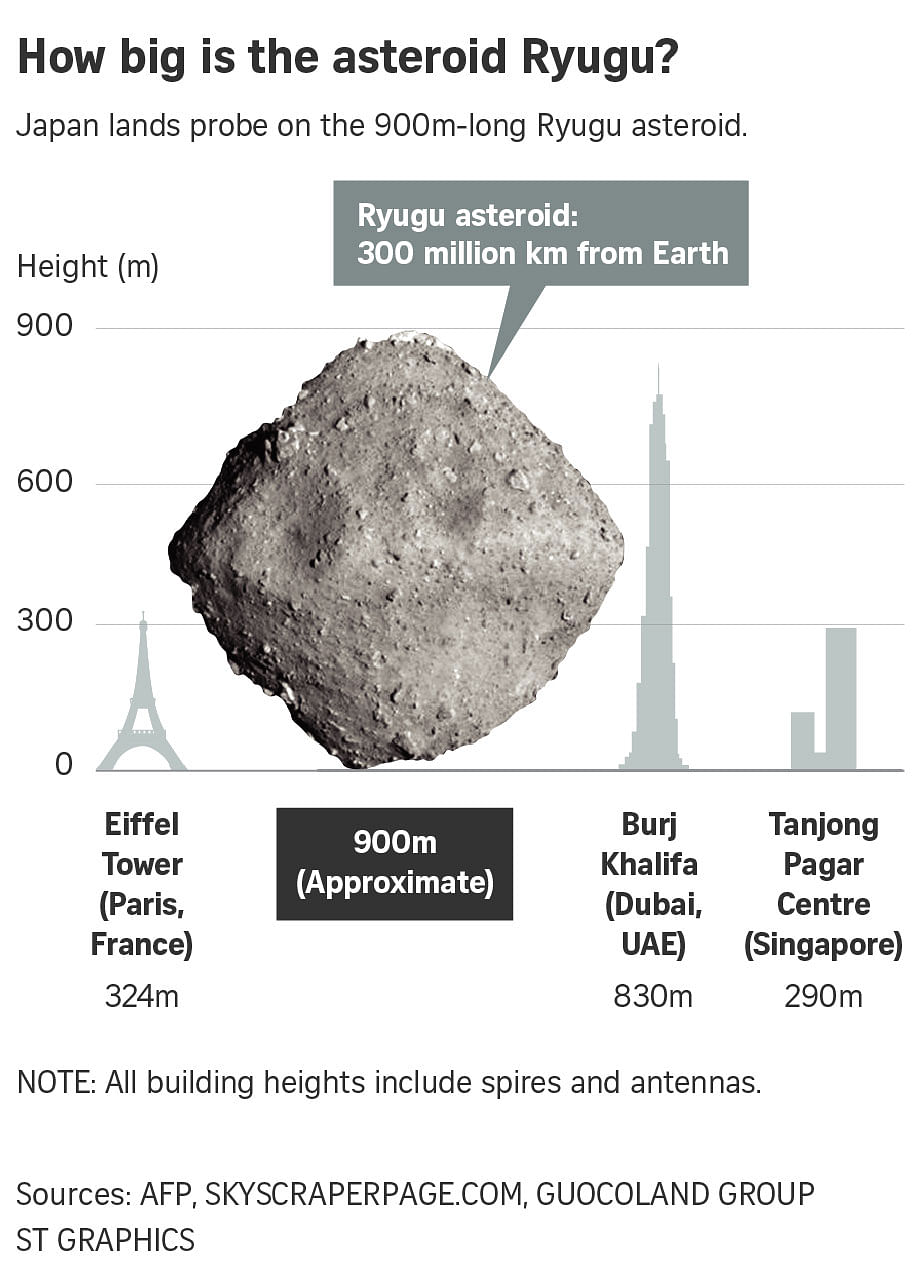Japanese spacecraft Hayabusa2 prepares to inspect crater it blasted in asteroid
Sign up now: Get ST's newsletters delivered to your inbox

Japan's space agency, Jaxa, will stream coverage from the Hayabusa2 control room during the operation on Thursday morning.
PHOTO: AFP
Follow topic:
TOKYO (NYTIMES) - When last we checked in with Japan's Hayabusa2 spacecraft in April, it had blown a crater in a large rock that orbits the sun.
On Thursday morning (July 11) in Japan, the robotic probe is scheduled to make a close inspection of its handiwork.
As it descends to the surface of the asteroid, designated as Ryugu, it will attempt to swiftly collect a sample of material that was exposed when that crater was created.
If the mission is successful, it will add to the cache of samples aboard Hayabusa2, which are to be brought to Earth next year for scientists to study for clues about the solar system's origins.
The landing attempt will occur at around 9.15pm Eastern time (10.15am Japan time, 9.15am Singapore time). Japan's space agency, Jaxa, will stream coverage from the Hayabusa2 control room during the operation, starting at approximately 8.30pm Eastern time.
WHY ARE SCIENTISTS STUDYING THIS ASTEROID?
Asteroids are bits and pieces leftover from the disc of gas and dust that formed around the young sun and never quite coalesced into a planet. They contain some almost pristine compounds that help tell what the solar system was like 4.5 billion years ago.
Ryugu, as dark as coal, is a C-type, or carbonaceous, asteroid, meaning it is full of carbon molecules known as organics including possibly amino acids, the building blocks of proteins. Such molecules are not always associated with biology and can form from chemical reactions in deep space, but asteroids could have seeded Earth with the organic matter that led to life.
About three-quarters of asteroids in the solar system fall into the C-type.
This space rock was discovered in 1999 and not given a name until 2015. Ryugu is named after Ryugu-jo, or dragon's palace - a magical undersea palace in a Japanese folk tale.

WHY DID JAPAN BLOW A CRATER IN RYUGU?
Hayabusa2 already landed briefly on Ryugu's surface, in February, and collected samples. But these surface materials have been exposed to the solar system's weather. Studying them offers scientists a potential picture of Ryugu's surface.
But that debris will not reveal much about the asteroid's geological history, just as the topsoil in your yard won't tell you much about what your neighbourhood was like during the last ice age.
Making a crater will offer clues to how asteroids similar to Ryugu respond to being struck by objects.
To create the dent in Ryugu, Hayabusa2 carried an impactor made of copper. According to the Planetary Society, a funnel containing plastic explosives hurled the copper projectile into the asteroid's surface.
The blast scattered material above the asteroid, altering an area with a diameter of just over 9m and creating a crater with a depth of about 1.8m to 3m. The impact also darkened the region and caused some boulders to move.
HOW WILL HAYABUSA2 LAND ON THE ASTEROID?
In short, very quickly.
To collect material from the surface of the asteroid, Hayabusa2 has targeted a small patch about 19m from the crater it created, not within the crater itself. The mission's scientists think this spot is covered in material ejected from beneath the crater when the blast occurred.
The spacecraft will try to pull samples in through a device called a sampler horn, after firing a small projectile made of the metal tantalum - basically a bullet - at the asteroid's surface.
The landing, bullet firing and attempted collection will all take about one second, according to the Planetary Society. Hayabusa2 will then rise from the surface and return to a safe distance near Ryugu.
Hayabusa2 already did this once in February. Because of that successful operation, the mission's managers in Japan had to assess whether it was worth risking the spacecraft again.
After the spacecraft made low-altitude observations of the landing area in the first half of June, the team concluded that conditions were safe enough for a second landing, and that the scientific value of collecting subsurface materials from the asteroid merited the try.
ISN'T NASA DOING SOMETHING LIKE THIS TOO?
Yes. The Osiris-Rex spacecraft is surveying a carbon-rich asteroid known as Bennu, and it too will collect samples and return them to Earth (although it will not be making any craters on Bennu's surface).
Bennu is even smaller than Ryugu, about 457m wide. Osiris-Rex will not return with its samples until 2023. Early research results announced in March also revealed that Bennu is more rugged than expected, and that it is shooting rocks from its surface into space.
Nasa and Japanese scientists plan to exchange samples of the two asteroids to compare the similarities and differences.
HAS JAPAN DONE THIS BEFORE?
As the 2 in Hayabusa2 indicates, this is the second time that Jaxa, the Japanese space agency, has sent a spacecraft to an asteroid.
Hayabusa2 is an improved version of Hayabusa, which visited a stony asteroid, Itokawa, in 2005. Despite several technical problems at Itokawa, Hayabusa returned a capsule to Earth in 2010 containing 1,500 particles from the asteroid.

